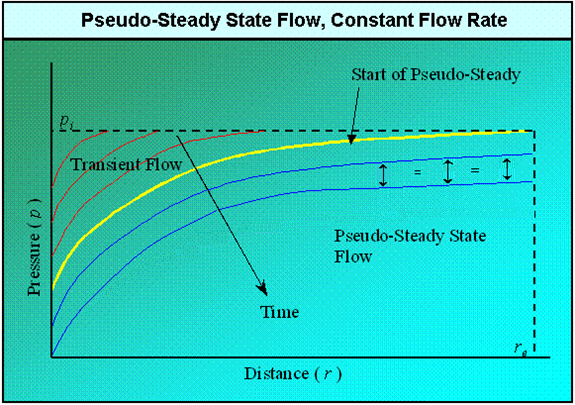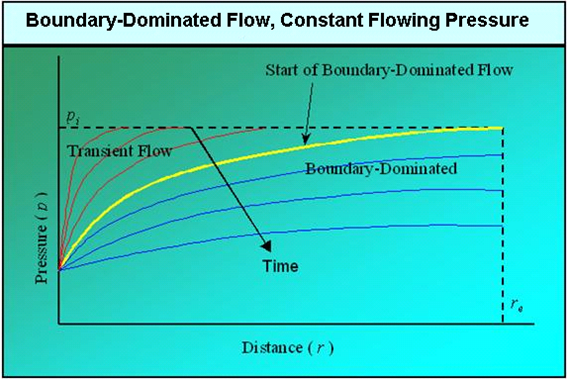Flow in a reservoir is often characterized as being one of two types: transient or boundary-dominated.
Transient flow takes place during the early life of a well, when the reservoir boundaries have not been felt, and the reservoir is said to be infinite-acting. During this period, the size of the reservoir has no effect on the well performance, and reservoir size cannot be determined except to deduce minimum contacted volume. Since the boundary of the reservoir has not been contacted during the transient flow period, static pressure at the boundary remains constant.
Pressure transient analysis / well testing theory relies heavily on the assumption that the well flows at a constant rate. Several terms are often used when describing flow from a well at constant rate:
- Transient Flow — The pressure transient migrates outward from the well without encountering any boundaries.
- Steady State Flow — The pressure transient has reached all of the boundaries but the static pressure at the boundary does not decline. This is often called “constant pressure boundary”.
- Pseudo-Steady State Flow — The pressure transient has reached all of the boundaries and the static pressure is declining at the boundary and declining uniformly throughout the reservoir.
- Boundary-Dominated Flow — The pressure transient has reached all of the boundaries and the static pressure is declining at the boundary, but not uniformly because the flow rate is not constant. This is also often called “tank-type flow”.
The following schematic chart shows the pressure distribution in the reservoir for a constant flow rate. The red lines represent the transient portion and the blue lines the pseudo-steady-state portion. The yellow line indicates the transition from transient to a pseudo-steady state. Note that the vertical distance between each line is uniform from near wellbore to the boundary.

The following schematic chart shows the pressure distribution in the reservoir for a constant-flowing pressure solution. Note that the flowing pressure of the wellbore is constant and the pressure distribution through the reservoir is not uniform.

The constant rate and constant-pressure solutions are boundaries that the actual walls approach, but never really achieve. Early production and formal production tests often very closely approach the constant-rate solution, whereas late time production generally very closely approaches the constant-pressure solution. Constant-rate solutions are important for conducting pressure transient analysis (PTA) for determination of key reservoir parameters such as permeability and damage, whereas the constant-pressure solutions are important for determination of original in-place volumes and recoverable reserves.